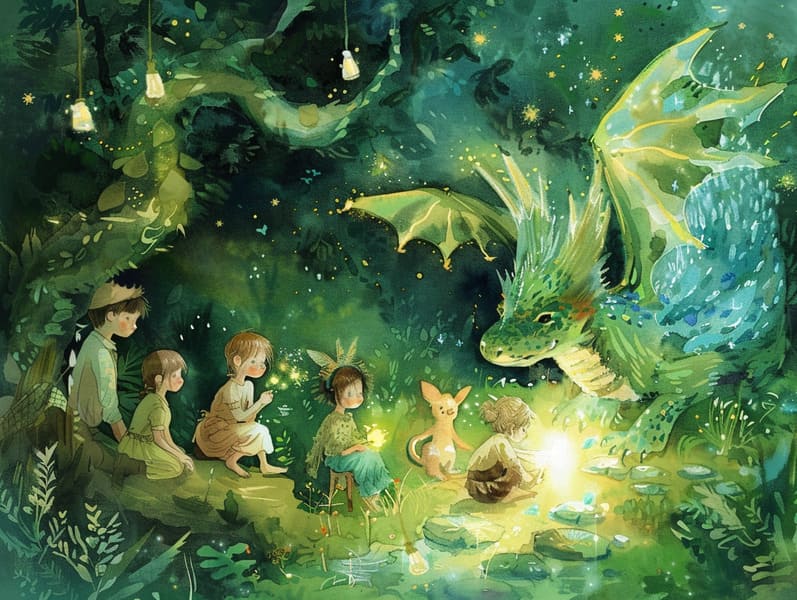The Inception of Timeless Fairy Tales and Its Persistent Allure.
The Inception of Timeless Fairy Tales and Its Persistent Allure.
Blog Article

Vintage fairy tales have long histories. These tales have been recounted from one generation to the next well before they were ever inscribed. They originated from a variety of cultures, including American traditions. They were initially told among grown-ups, often carrying themes and messages related to the societal norms and beliefs of the time.
The Brothers Grimm, Jacob and Wilhelm (the Grimm brothers), were among the first to gather many of these beloved narratives. Their collection, "Grimm's Folk Tales," included narratives like "The Little Glass Slipper," "Little Brother and Little Sister," and "Snow White," which have since become essentials in the world of beloved fairy tales. Similarly, Hans Christian Andersen's magical stories, such as "The Little Mermaid," and "The Little Duckling," have captured hearts worldwide, establishing their place in the pantheon of timeless fairy tales.
Despite being ancient, fairy tales remain as applicable as ever, especially as children's night stories. These charming stories are now available in numerous formats, including richly illustrated books, enchanting animations, and digital storybooks.
Their unwavering allure can be attributed to several enchanting factors:
Crucial Morals: Ancient fairy tales often teach important moral lessons. Tales like "The Tale of the Boy Who Cried Wolf" teach the virtue of honesty, while "The Story of the Tortoise and the Hare" point out the benefits of persistence and humility. These narratives offer kids clear distinctions between truth and falsehood, developing their moral compass in a mild yet profound way.
Empathy and Understanding: Timeless fairy tales frequently showcase heroines facing problems and hurdles, prompting audiences to connect with their struggles and applaud their triumphs. For instance, "The Story of Beauty and the Beast" conveys the significance of looking beyond appearances to know the true nature of a person, fostering tenderness and recognition.
Cultural Comprehension: Many classic fairy tales are saturated in the cultural contexts from which they originated. Discovering these tales can provide informative snapshots into different historical contexts, advancing a sense of cultural understanding and perception.
Inventiveness and Fantasy: The magical elements in timeless fairy tales—magical spells—invigorate children’s inventiveness. These tales guide readers to fantasy realms, boosting imaginative thinking and a sense of curiosity that persists a lifetime.
Ancient fairy tales are not only fascinating but also instructive. They provide spellbinding tools in promoting various intellectual and emotional capacities in the young. When old fairy tales are told out loud, they promote linguistic abilities by showing new word meanings and complicated sentence structures. This practice also nurtures hearing abilities and attention span, as kids follow the story, anxious to see what happens next.
Furthermore, talking about the themes and characters of fairy tales can develop logical thinking and problem-solving abilities. Young readers learn to identify patterns, make predictions, and figure out cause and effect. These reflections also aid young readers express their thoughts and feelings, contributing to their emotional intelligence.
In today’s cyber age, the presence of free fairy tales online has made these fairy tales more accessible than ever. Web-based platforms and web apps present large libraries of traditional fairy tales that can be enjoyed or listened through anytime, anywhere. Fairy tales narrated are particularly common, providing an immersive method for young readers to relish these bewitching tales. Sound books and read-out-loud videos move characters and settings to life, often supported by entrancing melodies and melodies that intensify the narrative experience.
The timeless appeal of classic fairy tales lies in their ability to alter to today's world while continuing with their main lessons. Contemporary updates of these narratives often incorporate more different characters and modern settings, making them familiar to today’s audience. However, the central morals of valor, empathy, and even-handedness remain unchanged, continuing to touch young listeners of all ages.
Ancient fairy tales also offer a sense of security and comprehensibility. They distribute a well-ordered narrative with a transparent beginning, middle, and end, often drawing to a close with the ending of conflicts and the triumph of honesty over deceit. This certainty can be placating for children, spreading a sense of consistency in an shifting world.
Old fairy tales continue to delight and edify new generations, maintaining their mystique and relevance in modern society. As kids' bedtime tales, they introduce a perfect blend of allure and teaching, developing moral values, empathy, and creativity. The proliferation of online storybooks and the widespread nature of fairy tales read out loud promise that these classic narratives remain available to new generations.
By defending and broadcasting these fairy tales, we continue to admire the rich tapestry of tradition and cultural heritage. Whether you are accessing a gorgeously illustrated book, discovering a digital library, or hearing an voice book, the loveliness of bedtime fairy tales is always within reach. These fairy tales convey of the perpetual spell of fairy tales and its ability to unite us across epochs and places.
Even if you are accessing a colorful picture book, experiencing a cyber library, or playing an voice book, the beauty of Grimm's fairy tales is always within reach.
These fairy tales point out of the consistent power this site of storytelling and its ability to unite us across epochs and places, casting a charm that captivates and teaches alike.